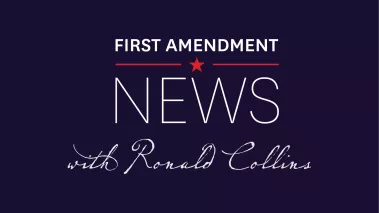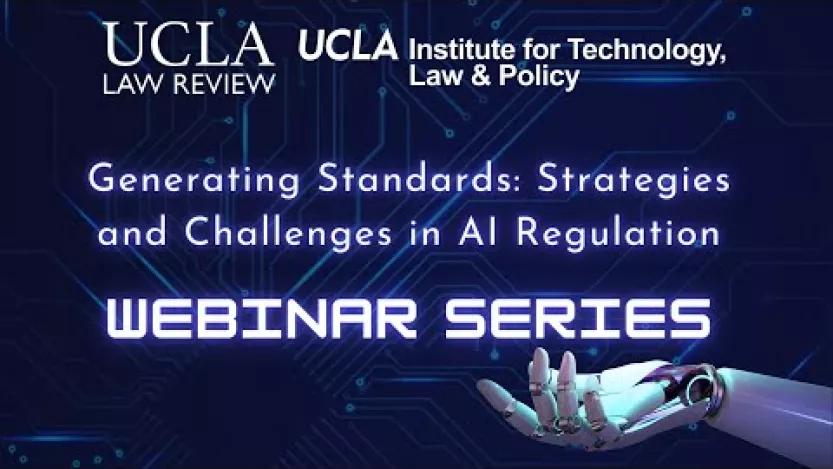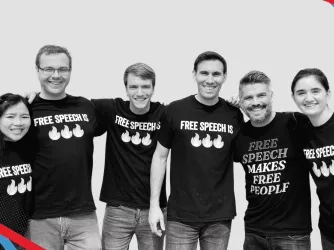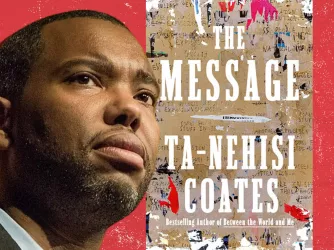Table of Contents
‘Your Next Stop’: The Twilight Zone of A.I. and the First Amendment — First Amendment News 391

In 2018, David Skover and I published “Robotica: Speech Rights and Artificial Intelligence” (Cambridge University Press). Much of that book was written in 2017 when there was no real law, let alone First Amendment law, directly related to artificial intelligence and speech. It wasn’t even clear to what extent, if any, First Amendment law even covered expression created and communicated by AI. And even if it did, there was no idea about just how the First Amendment might operate as a constitutional defense in this unmapped area. Based on what was known at the time — five years in AI time is a long time! — we sketched out a few conceptual contours of how the First Amendment might begin to operate in this new technological realm.

Legally speaking, little has changed in the United States since we published “Robotica.” In a recent New York Times article titled, “In U.S., Regulating A.I. Is in Its ‘Early Days’,” Cecilia Kang wrote:
Regulating artificial intelligence has been a hot topic in Washington in recent months, with lawmakers holding hearings and news conferences and the White House announcing voluntary A.I. safety commitments by seven technology companies on Friday.
But a closer look at the activity raises questions about how meaningful the actions are in setting policies around the rapidly evolving technology.
The answer is that it is not very meaningful yet. The United States is only at the beginning of what is likely to be a long and difficult path toward the creation of A.I. rules, lawmakers and policy experts said. While there have been hearings, meetings with top tech executives at the White House and speeches to introduce A.I. bills, it is too soon to predict even the roughest sketches of regulations to protect consumers and contain the risks that the technology poses to jobs, the spread of disinformation and security.
Against that backdrop, Kang added:
The United States remains far behind Europe, where lawmakers are preparing to enact an A.I. law this year that would put new restrictions on what are seen as the technology’s riskiest uses. In contrast, there remains a lot of disagreement in the United States on the best way to handle a technology that many American lawmakers are still trying to understand.
The ‘evolution’ is coming!
Evolution does not respect constitutions, customs, or creeds. It washes over them like waves erode shorelines. This means that we must approach AI communication with a certain open-mindedness, a preparedness to question our presuppositions, and a willingness to embrace, however guardedly, what seems inevitable. That is to say, the inevitable may not always be in sync with today’s view of the law — or even with today’s understanding of what it means to be a communicative human being.
Know this: AI communication will produce new and dizzying paradoxes in the law of free speech.
There is concern that super-intelligent AI might eventually be able to improve itself to the point that humans could not control it.
That said, there are ever more signs in the emerging literature and developing law that the next major development in First Amendment jurisprudence will be where concerns about the harms of AI run up against any possible First Amendment defenses.
The Journal of Free Speech Law, for example, just posted a “Symposium on Artificial Intelligence and Speech.” On the law front, a libel suit was recently filed in Georgia involving a ChatGPT-generated libelous posting — the case is Walters v. OpenAI L.L.C., (Sup. Ct., Gwinnett Co., GA, June 2, 2023). According to an Associated Press story — and duly mindful of possible legal liability — AP and other news organizations are developing standards to supervise the use of artificial intelligence in newsrooms.
Fears about AI’s potentially harmful effects are attracting ever more attention in the law world. For example, in a 2023 supplement to their constitutional law casebook, professors Geoffrey Stone, Louis Seidman, Cass Sunstein, Mark Tushnet, and Pamela Karlan, et al, write:
There is concern that super-intelligent AI might eventually be able to improve itself to the point that humans could not control it. ChatGPT, a recently released version of AI, now has more than 100 million users who engage in a broad range of conversations with chat ChatGPT. A key question is how the First Amendment impacts this revolution in artificial intelligence.

The contours of AI issues and the free speech principle
To provide some examples of recent developments on the AI and free speech front, consider the following:
Section 230
- Hasala Ariyaratne, “ChatGPT and Intermediary Liability: Why Section 230 Does Not and Should Not Protect Generative Algorithms,” SSRN (May 16)
- Graycve McCormick, “Does Section 230 cover artificial intelligence? Experts are not sure,” Iowa News Now (July 11)
First Amendment
- Cass R. Sunstein, “Artificial Intelligence and the First Amendment,” SSRN (April 28)
- Karl Manheim and Jeffrey Atik, “White Paper: AI Outputs and the First Amendment,” SSRN (Aug. 2)
- “‘So to Speak’ podcast transcript: Artificial intelligence: Is it protected by the First Amendment?” FIRE (Jan. 26)
- William F. Freivogel, “Can the First Amendment keep up with the deluge of machine created information?” Gale Academic Onefile (Winter 2023)
- Bill Tomlinson, Donald Patterson, and Andrew Torrance, “Turning Fake Data into Fake News: The A.I. Training Set as a Trojan Horse of Misinformation,” San Diego Law Journal (July 25)
- R. George Wright, “A Free Speech-Based Response to Media Polarization,” SSRN (June 22)
- Richard Stengel, “The Case for Protecting AI-Generated Speech With the First Amendment,” Time (May 9)
- Alan Rozenshtein, “ChatGPT and the First Amendment: Whose Rights Are We Talking About?,” Lawfare (April 4)
- Russell L. Weaver, "Robotic Speech and the First Amendment," IMODEV (2023)
- Helen Norton, “Robotic Speakers and Human Listeners,” Seattle University Law Review (2018)
Defamation
- Miles Klee, “ChatGPT Is Making Up Lies — Now It’s Being Sued for Defamation,” Rolling Stone (June 9)
- Elizabeth Nolan Brown, “The A.I. Defamation Cases Are Here: ChatGPT Sued for Spreading Misinformation,” Reason (June 7)
- Eugene Volokh, “First (?) Libel-by-AI (ChatGPT) Lawsuit Filed,” The Volokh Conspiracy (June 6)
- Mark Lemley, Peter Henderson, and Tatsunori Hashimoto, “Where's the Liability in Harmful AI Speech?” SSRN (Aug. 15)
Other
- Robert W. McGee, “Do Institutional Review Boards (IRBs) Violate the Rights of Free Speech and Press? A Study of Artificial Intelligence and Philosophy,” SSRN (May 18)
Twelve questions (among others) to consider about AI and the First Amendment

“There are, of course, many nuances and potential challenges here.” — Eugene Volokh, Mark A. Lemley and Peter Henderson (2023)
- Is the content in question violative of any law, and how exactly is it so?
- Can the source of the harm be identified with certainty?
- Is the content protected under Section 230?
- Does the content constitute expression under the First Amendment?
- Is the law regulating the AI content narrowly tailored?
- What exactly is the harm alleged (e.g., defamation, fraud, insider trading, trade secrets, national security breach, true threats, speech integral to criminal conduct, etc.)?
- If such harm exists, can the causation requirement be satisfied?
- What is the gravity of the harm alleged?
- Do any First Amendment values outweigh the harm alleged?
- How, if at all, do the rights of listeners (receivers of information) figure into the First Amendment equation?
- How does the doctrine of prior restraint operate in a particular AI context?
- Where does the liability rest and what is the applicable remedy?
More in the news
- “Tennessee Republican Lawmaker Orders Removal of Public During Special Session on Gun Legislation,” First Amendment Watch (Aug. 23)
- “Kansas Agency Says Initial Online Search That Sparked Newspaper Raid Was Legal,” First Amendment Watch (Aug. 22)
- “Kansas Newspaper Raid Likely Broke the Law, Experts Say,” First Amendment Watch (Aug. 21)
- Pitasanna Shanmugathas, “Interview — Law Professor Marjorie Cohn: Extradition of Julian Assange Threatens First Amendment, Press Freedom,” Jurist (Aug. 21)
- Dennis Hetzel, “Appeals court sides with anti-abortion group in free-speech case,” The Free Speech Center (Aug.21)
- Susanna Granieri, “Tennessee School Removes Student Suspension Over Memes Following First Amendment Lawsuit,” First Amendment Watch (Aug. 18)
- “LAWSUIT: FIRE sues to stop California from forcing professors to teach DEI,” FIRE (Aug. 17)
- John Hanna and Jim Salter, “Kan. prosecutor says police should return computers, cellphones seized in newspaper raid," The Free Speech Center (Aug. 17)
2022-2023 SCOTUS term: Free expression and related cases
Cases decided
- 303 Creative LLC v. Elenis (6-3 per Gorsuch for the majority and Sotomayor for the dissent: The First Amendment prohibits Colorado from forcing a website designer to create expressive designs speaking messages with which the designer disagrees.)
- Counterman v. Colorado (held: First Amendment violated — 4 votes per Kagan with Sotomayor concurring in part joined by Gorsuch in part. Thomas filed a dissent and Barrett also filed a dissent, in which Thomas joined). (“In this context, a recklessness standard — i.e., a showing that a person ‘consciously disregard[ed] a substantial [and unjustifiable] risk that [his] conduct will cause harm to another’ . . . — is the appropriate mens rea. Requiring purpose or knowledge would make it harder for States to counter true threats — with diminished returns for protected expression. The State prosecuted Counterman in accordance with an objective standard and did not have to show any awareness on Counterman’s part of his statements’ threatening character. That is a violation of the First Amendment.”)
- Jack Daniel’s Properties, Inc. v. VIP Products LLC (9-0: held — When a defendant in a trademark suit uses the mark as a designation of source for its own goods or services — i.e., as a trademark — the threshold Rogers test for trademark infringement claims challenging so-called expressive works, see Rogers v. Grimaldi, does not apply, and the Lanham Act’s exclusion from liability for “[a]ny non-commercial use of a mark” does not shield parody, criticism, or commentary from a claim of trademark dilution.) (This is from footnote 1 of the majority opinion: “To be clear, when we refer to ‘the Rogers threshold test,’ we mean any threshold First Amendment filter.” Justice Kagan wrote the majority. Justice Sotomayor filed a concurring opinion, in which Justice Alito joined. Justice Gorsuch filed a concurring opinion, in which Justices Thomas and Barrett joined.)
- United States v. Hansen (7-2: Title 8 U.S.C. § 1324(a)(1)(A)(iv) — which criminalizes “encouraging or inducing” illegal immigration — forbids only the purposeful solicitation and facilitation of specific acts known to violate federal law and is not unconstitutionally overbroad.)
Review granted
- Vidal v. Elster
- O’Connor-Ratcliff v. Garnier
- 303 Creative LLC v. Elenis (argued Dec. 5)
- Jack Daniel’s Properties, Inc. v. VIP Products LLC (argued March 22)
- United States v. Hansen (argued, March 27) (Volokh commentary here)
- Counterman v. Colorado (argued, April 19)
Cert. granted and case remanded
- U.S. v. Hernandez-Calvillo (cert. granted, judgment vacated, and case remanded to the U.S. Court of Appeals for the 10th Circuit for further consideration in light of United States v. Hansen) .
- Klein v. Oregon Bureau of Labor and Industries (cert. granted, judgment vacated, and case remanded to the Court of Appeals of Oregon for further consideration in light of 303 Creative LLC v. Elenis).
Pending petitions
- O’Handley v. Weber
- Center for Medical Progress v. National Abortion Federation
- Mazo v. Way
- Tingley v. Ferguson
- Frese v. Formella
- National Rifle Association of America v. Vullo
- Moody v. NetChoice, LLC
- NetChoice, LLC v. Moody
- Florida v. NetChoice
State action
- O’Connor-Ratcliff v. Garnier (cert. granted)
- Lindke v. Freed (cert. granted)
Qualified immunity
- Novak v. City of Parma (cert. denied)
Immunity under Foreign Sovereign Immunities Act
- NSO Group Technologies Limited v. WhatsApp, Inc. (cert. denied)
Liability Anti-Terrorism Act
- Twitter v. Taamneh (held, 9-0 per Thomas, J.: SCOTUSblog: “Plaintiffs’ allegations that the social-media-company defendants aided and abetted ISIS in its terrorist attack on a nightclub in Istanbul, Turkey fail to state a claim under 18 U.S.C. § 2333(d)(2).”)
Section 230 immunity
- Gonzalez v. Google (held, 9-0, per curiam, SCOTUSblog: “The 9th Circuit’s judgment — which held that plaintiffs’ complaint was barred by Section 230 of the Communications Decency Act — is vacated, and the case is remanded for reconsideration in light of the court’s decision in Twitter, Inc. v. Taamneh.”)
Review denied
- Mobilize the Message v. Bonta
- North Carolina Sons of Confederate Veterans v. North Carolina Dept. of Transportation
- Price v. Garland
- Keister v. Bell
- Morgan v. Arizona
Previous FAN
FAN 390: “Eight questions for participants in upcoming National Constitution Center First Amendment Summit”
This article is part of First Amendment News, an editorially independent publication edited by Ronald K. L. Collins and hosted by FIRE as part of our mission to educate the public about First Amendment issues. The opinions expressed are those of the article’s author(s) and may not reflect the opinions of FIRE or of Mr. Collins.
Recent Articles
FIRE’s award-winning Newsdesk covers the free speech news you need to stay informed.

How to survive Thanksgiving

Right, left, and in-between: Can we bring our differences to the table?

FIRE is the proud home for those who defend free speech


